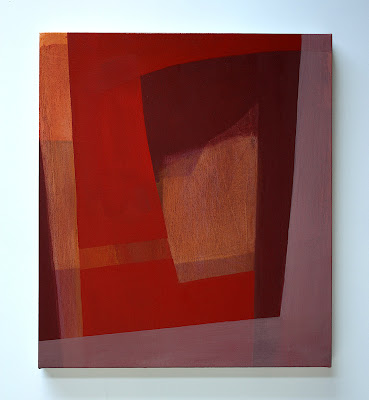Recently I had the opportunity to visit the studio of Philadelphia based painter, James Erikson.
Erikson makes quiet, yet insistent paintings - process oriented, oil on canvas, works that linger in the mind of the viewer, demanding interpretation. In the same way a passage of music can seem familiar, though it has never been heard, Erikson's paintings stir underlying thoughts and feelings that are more race memory than personal experience.
The resulting works are august, influential forces that are hard to define but easy to know.
James Erikson in his studio. Piladelphia, 2012.
From the Artist's Statement:
I make nature-based abstractions with special attention given to layering and surface variety. The imagery is a dialogue between organic and geometric. I use natural colors, carefully chosen color relationships with nature-influenced light.
I want to see the physicality of the process but still retain a mystery as to how the painting transpired. The surface is worked, reworked, and scraped down.
My paintings are abstractions in the sense that at some point in the painting process I’m abstracting from nature, whether consciously at the beginning or through some experience or memory I bring into the studio during the evolution of the painting. Sometimes the painting reminds me of something, a particular mood or memory of a place and it won’t go away -- that becomes the subject of the painting for me.
My goal is to make relevant contemporary paintings while paying close attention to art history, to find something new within the tradition of abstract painting. I am drawn to the simple forms of monuments and monoliths but also to their deep connection to life and death. My paintings aren’t about particular monuments or monoliths but I do want them to function on a similar, basic human level emotionally. They are reflective of the contemporary human experience.
For my latest series I have been using Lawrence Durrell’s Alexandria Quartet novels as a bouncing off point. The last few years I have made contemporary Modernist abstractions that connect to human history and emotions through ancient art and artifacts: the capacity of art to connect to death and memorial.
What drew me to the novels was the telling of an event through different characters. It reminded me of Claude Monet’s paintings of the same scene in differing light and weather. How as humans we read the same story or look at the same abstract painting and come away with a whole different take on it.
Another reason for my interest in the Alexandria Quartet is Durrell’s success at synthesizing history with the contemporary. The exotic backdrop and cultural history of place permeates throughout the book; and the climate, dust, and language function as other characters as well.
For my Quartet series I have been using resource imagery from Coptic Christian art, the architectural and cultural backdrop of Durrell’s novels. My use of resource imagery is a lot like how I imagine a Chinese scholar’s rock functions: a special object in one’s possession that can connect an artist to nature and human history.
To view more of Erikson's work visit his website here.
*All images © James Erikson and the blog author.





























3 comments:
these are da bomb. fragmentary and whole, determined and wildly inventive, scuzzy and majestic. i'm so sick of good painting and bad painting and these really work- each one is a discovery and yet there is a clear voice, or set of predilections - he knows himself, to an extent, but he's not cranking out variations on a theme.
Beautiful work! Great review to Paul. The paintings remind me of Charlotte Park's collages.
Thanks Paul for this wonderful post.
Loved James Erikson's work!
Post a Comment